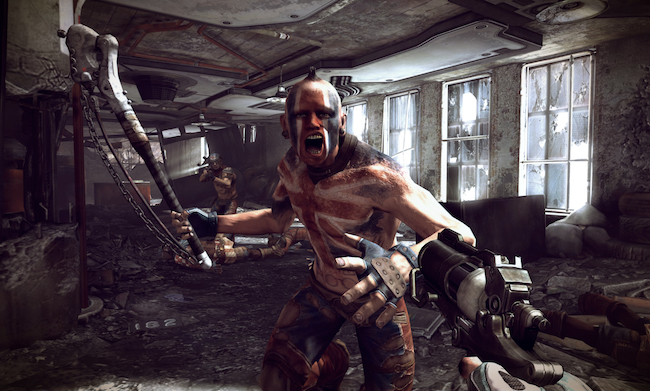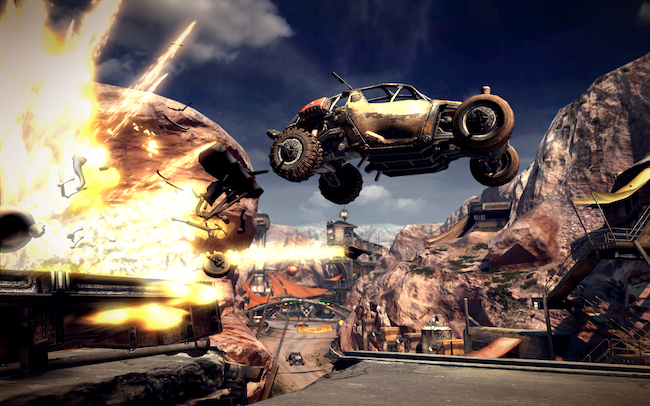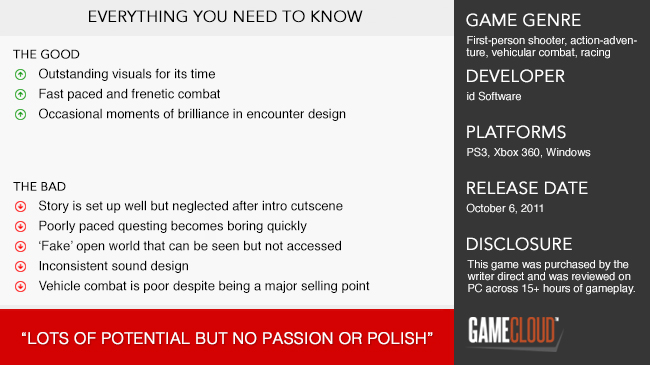
Fans of open world adventures were absolutely spoiled for choice in 2011, with exceptional works from genre pioneers Bioware (Dragon Age II), lauded sophomores CD Projekt RED (The Witcher 2: Assassins of Kings) and industry juggernauts Bethesda (TES V: Skyrim). Amongst titles of such a high calibre, it must have taken incredible guts from id Software to release their first vision of an FPS/Open World hybrid in RAGE; a title that works hard to differ itself from the competition with a unique blend of brutal gunplay, chaotic vehicular combat and some RPG-lite quest and upgrade elements to give it some pace and purpose. I sat down with RAGE to see how it held up six years after release.
RAGE made a big splash in the games industry with what were stunning visuals at the time. Facial animations are beautifully detailed and expressive, producing NPC characters that were not only well designed visually, but moved and emoted with more fluidity than you’d expect from a game of its time.
Staggering vistas and huge maps, made possible with a new mass texturing technology id Software designed for the title, contribute to a world that feels much larger than anything presented in a traditional FPS before. Some great variety exists between zones as well, including barren desert wastelands, ruined concrete cities filled with decrepit buildings and demolished highways, and meteor craters that hum with alien energy. Indoor zones are a little less exciting, mostly run down buildings and the occasional cave. However, you’re never held inside for long enough to feel bored or constrained.

The vast open world of RAGE is almost completely empty, though. Scattered towns and the occasional lone NPC are your points A and B while travelling for quests and side-content, but there are no reasons to leave your vehicle between landmarks and explore these open spaces. In a way, you’re actively discouraged from doing so by the existence of invisible walls at illogical places throughout the entire map. Every time a building or object in the distance caught my eye, I would try to investigate only to be jarringly interrupted by a railing I couldn’t jump over, a smashed wall I couldn’t step through or a gentle slope that couldn’t be climbed. Whenever I could fully explore an enticing detour, I reached a blank dead-end with nothing so much as an ammo refill or some bandages to pick up. This huge world was designed to be seen but not walked upon or scoured for rewards.
As such, your adventure in this world feels less like a sprawling epic and more like a linear back-and-forth between locations, driving for a few minutes just to leave the car, pick up an item, kill a few enemies and then drive a few minutes back. There were times when I had 4 or 5 quests in my journal but still felt starved for choice because they all involved the same drive/kill/item requirements and all the destinations were in the same areas. When I wanted a change of scenery or to get away from the main game for a while, an essential option in any open world game, I was unable to.
You are shepherded through the game and at no point did I feel enabled or encouraged to look for more things to do or other places to go. In keeping with the below average pacing of the game, the majority of missions felt more like errands without any urgency and not contributing to a grander narrative at all. Generic bandits attacked a generic merchant, and we have to collect his generic goods.

The experience is punctuated, however, by some longer, tougher story missions that introduce over-the-top set pieces, problem-solving mechanics, jump scare moments and some truly memorable enemy encounters. RAGE proves itself capable in these moments, but sadly they are too few and far between.
Combat shines as the highlight of the RAGE experience, with frenetic encounters designed so that enemies surprise you from all angles and use unpredictable movement and the varied terrain to confuse and overwhelm you. The AI isn’t very smart for a game made this century, and while that does break the immersion of combat against human enemies, it lends an animalistic and rabid feel to the mutated creatures that you face, as they sprint headfirst into your line of fire and are undeterred by damage.
Speaking of fire, the weapons in RAGE are varied and genuinely lend themselves to different tactical situations, creating a decision to be made at the start of each fight. Firearms feel powerful to wield and throw force into enemies with each shot, particularly id’s usual pièce de résistance, the shotgun. Additional ammo types become available later in the game, as well as grenades and other auxiliary weapons to open up some new tactical options. Crossbows and throwing weapons exist to provide a quieter approach. Quiet weapons are a nice change in RAGE because the shot sound effects are astonishingly bad. Every weapon sounds fake and lo-fi; it feels like PS2/Xbox era sound appearing in a PS3/X360 era game. This is particularly surprising given the high-quality sound design in other parts of the game.

Vehicular combat is fun to a degree, but not quite as tight as its on-foot counterpart. Poorly polished physics coupled with sluggish controls have you flipping and spinning all over the place by accident, resulting in the feeling that you aren’t in complete control of the vehicle, and that you’re really just holding accelerate and fire and hoping for the best. The fact that the developers decided to give you auto-aim and target tracking is basically an admittance that their vehicle controls were too poor for players to pilot alone. The controls work a little better in the racing mini-game, as it’s less arena based and you’re at least able to focus on moving forward rather than having to aim for an enemy. As a side note, I was unable to test the multiplayer vehicular combat, or the co-op combat mode for that matter, as the game seems to have no active online community.
RAGE’s premise is delivered to you in surprisingly poetic fashion through the game’s introductory cutscene, depicting Earth in the shadow of a rapidly approaching meteor and the subterranean exodus of a small group of humans with the intention of surfacing 100 or so years later and rebuilding human civilisation.
Your character awakens from stasis and exits the ‘Ark’ into a Mad Max style wasteland, at which point all excitement about a rich and dramatic plot line is torn from you in favour of immediately (and I mean literally the first thing that happens) being handed a weapon and instructed to clear out a nearby camp of cookie-cutter bandits. Forget obvious questions the player, and the protagonist, will have such as “Where am I?”, ‘What year is it?”, “Who are you?”. Nope. Stasis Patient to Killing Machine in two minutes flat. This sets the tone for the rest of the game, in which action never gives way to story, and even after 15 hours with RAGE, all of these questions remain not only unanswered but completely unaddressed.

RAGE is an overall weak offering from a developer who may have been out of their depth. I can’t help but think that if id Software had made another DOOM style shooter in this new IP, they’d have been in familiar territory and would have done a better job. As it turns out, all elements of the game outside of the FPS combat are of poor design, and it doesn’t feel as though any passion was poured into the crafting of the adventure or the narrative. It simply is not on the same level of quality as other games released in 2011, and frankly doesn’t even compete with similar titles released years earlier. I can’t recommend it. Go play Borderlands (2009).











